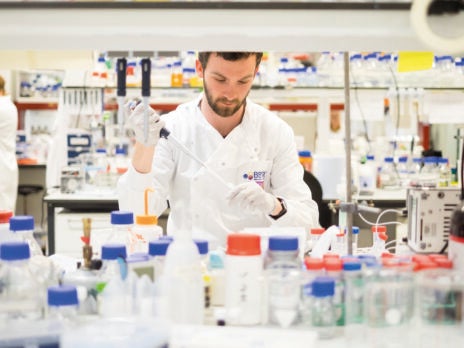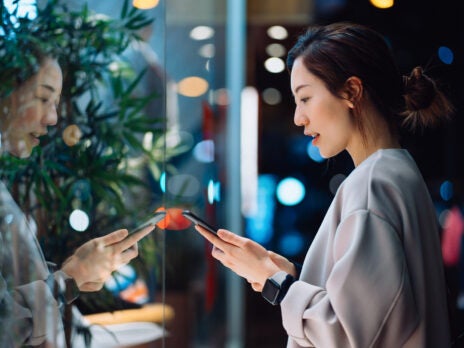What Did Georgia Oã¢ââ¢keeffe Think Was the Goal of Art?

Georgia O'Keeffe was never just a painter. In later life, when she was living at her adobe house in Abiquiú – one of two properties she endemic about fifty miles northward of Santa Fe, deep into barren New Mexico – an artistic pilgrim arrived at her gate and yelled that he wanted to come across her. Miss O'Keeffe, as she was always known in the hamlet, emerged from the garden, dressed equally ever in black clothes of her ain design that gave her a crisp, sculptural outline, hair pulled back to highlight her potent if severe face. She didn't open the gate to the stranger but stood in front of him before giving him a twirl. "There," she said, "now you've seen me," and shooed him away. Here, in one incident, is O'Keeffe: self-confident, self-independent, haughty and fully enlightened of the value of an anecdote.
O'Keeffe (1887-1986) had had a long fourth dimension to perfect her persona. She had been famous since the early 1920s and knew only how potent her image was. She remains all-time known for her paintings of flowers, which have ever been held to resemble female genitalia. The link was first made in 1924, at the very kickoff of her career, when some of her flower pictures were exhibited in New York aslope a selection of photographs of nudes (many of her) by Alfred Stieglitz, the lensman, dealer and mentor whom she married that same year. Although O'Keeffe denied this sexualised reading of her work – ". . . you hung all your ain associations with flowers on my flower and you write about my bloom every bit if I think and encounter what you recollect and encounter of the flower – and I don't" – she recognised that the frisson was adept for sales and she both carried on painting flowers and posing naked for Stieglitz.
Throughout her life O'Keeffe kept her public epitome in a proficient land of repair. She was very conscious of her status as a feminist heroine, a pioneer modernist who turned her back on the due east coast arts scene, an dogged effigy who fabricated her dwelling in the unknown and barely accessible regions of the far due south-west and produced there a distinctive and wholly American art. All this was true and she buffed information technology upward. Equally she was too well aware from her married man and from her close friendships with the photographers Paul Strand and Ansel Adams, her hit looks and apparel were extremely camera-friendly. Although she was most always in company (friends, staff, assistants) photographs of her – and she was i of the most photographed women of the American 20th century – invariably bear witness her on her own, a solitary figure facing the world, her companions advisedly cropped from the scene. She believed that Americans look similar fools considering they grin all the time, so she rarely smiled in photographs.
The legend of O'Keeffe is so awe-inspiring that her art sometimes seems secondary. With some artists – Picasso, for example – the work lives up to the human; with others, such every bit Frida Kahlo (coincidentally a friend of O'Keeffe'south), not so much. In that location is, remarkably, not a single painting past O'Keeffe in a British public collection, which makes the retrospective of her work at Tate Modern, the largest e'er held outside America, a unique opportunity to meet just how much she deserves her hallowed reputation.
If O'Keeffe's personality was all most control so, also, was her fine art. Born on a farm in Wisconsin, she was initially drawn to music just when she turned to painting she gave herself a thorough theoretical grounding before she always touched a canvas. She studied in both Chicago and New York and learned about modernism from the painter and educator Arthur Wesley Dow. Believing she wouldn't make it as an creative person, she took a job as a commercial designer in Chicago. What changed things for her was when she sent some drawings to a friend who, without her knowledge, showed them to Stieglitz, who then, again without O'Keeffe'southward knowledge, exhibited them at his 291 gallery in New York (where he had been the offset person to show Cézanne'southward piece of work in America). "Finally," he wrote, "a woman on paper." A correspondence between the pair followed, then a coming together, then a solo prove, and finally marriage.
For an eager modernist, New York was the place to be and even as she painted her beginning bloom pictures, she as well produced pared-downwards images of the city'due south skyscrapers every bit well as abstract works total of wavy lines and pastel colours that are her visual response to music, and evidence how influenced she was past Kandinsky's teachings on synaesthesia (the correlation of the senses). Although they were painted partly to quieten the gendered reading of her work, which Stieglitz continued to encourage, her vertiginous views showing New York as a moonlit urban canyon are strangely prescient, pre-dating the bluffs and rock formations she later on painted in New United mexican states.
Content from our partners



"I have been much photographed," she said: "I am at nowadays prejudiced in favour of photography." And then her paintings mirrored the cropping and close focus of her husband's work, zooming in on flowers or buildings and presenting them oversized and tight to the picture frame. Information technology was both a ways to simplify her subjects and a way of turning the real into the abstract.
***
It was also in New York that O'Keeffe met Mabel Dodge Luhan, an creative socialite who, had she been British, would have been a fellow member of the Bloomsbury set. Her Charleston was a house in Taos, New Mexico, which she turned into an boggling cultural hub. Carl Jung, Willa Cather, Martha Graham, Leopold Stokowski, D H and Frieda Lawrence were all visitors, every bit was, in 1929, O'Keeffe. She made the long journeying w non just to sample this unfamiliar earth just besides to escape Stieglitz's relentless philandering, travelling with Rebecca Strand, wife of the photographer Paul. O'Keeffe was no innocent, either, writing to Strand that she wanted to kiss him and going even further with Rebecca, starting an thing with her.
Luhan told her shrink: "O'Keeffe is coming out in May. Finally, someone will paint the country." I of the places she painted was the pueblo settlement near Taos that was home to Mabel'southward quaternary husband, Tony Luhan, a Native American whose name she took. Mabel hoped that her house would be a heart for facilitating the interplay between Western artists and Native American culture; with O'Keeffe, she succeeded to a degree, and with D H Lawrence, too. It was Mabel who gave Lawrence a 160-acre ranch in the hills in exchange for the manuscript of Sons and Lovers (which she later gave to a friend to pay off his psychiatrist's bill). Her own beloved life was far from straightforward: she married four times and three of her husbands had syphilis. Many years after Mabel'south house was bought by Dennis Hopper, who had stayed at that place while filming Easy Rider.
Even though O'Keeffe's relations with Mabel were strained, New United mexican states had an immediate result: "Equally soon equally I saw it, that was my country. I'd never seen anything like it before, but it fitted to me exactly." In the harsh landscape she found the perfect subject field for what she called "the Great American Thing" – art of accurate, deep America – and she visited every subsequent year, buying a house there in 1940. What she plant around her homes at Ghost Ranch and afterwards Abiquiú was something both tangible and intangible: motifs of rocks, cliffs and animal skulls that matched perfectly with her ain, innate sense of blueprint, her sense of geological place, and also a version of the old cliché about painterly light – the dry out air giving bluer skies, crisper shadows and unmodulated light.
The s-west was perfect for her photographic sensibility and it also suited other aspects of her modernist technique, such as her lack of interest in perspectival recession and her flat, graphic, oft bland application of paint. Even when showing vast landscapes and ranges of hills, hers are pictures that insist on their ii-dimensionality. Unlike with conventional landscapes, there is no stepping into them. If this would seem to put her at one remove from her environs, the opposite was in fact the case. Hers was an analytical, enquiry-based art: she fabricated "colour fries", painted canvas swatches, to see how different colours worked next to one another and even trimmed her brushes into specific shapes. She would also line upward samples of soil on her palette to ensure the fidelity of her tones and although she frequently drew exterior she rarely painted en plein air: the act of laying on colours was her manner of expressing her feelings in front of the mural.
Although O'Keeffe was wealthy and had staff to assist her, she however led a monastically disciplined life. She would get up early to catch the right light on rock formations, turned her Model A Ford into a movable studio and idea zip of driving 150 miles to paint a hitting mountain range she called "the Black Place" – retreating beneath her car for shelter when the sun became too fierce. During the structure of her business firm and studio at Ghost Ranch, 19 rattlesnakes were killed as workers cleared the site and fear of snakes was office of the reason she slept on the adobe building'southward apartment roof, rather than simply for the absurd and a view of the night sky.
From the roof she could as well run into the Cerro Pedernal mountain. Just as Cézanne was obsessed with the Mont Sainte-Victoire, and then Cerro Pedernal held a fascination for her: "It's my private mount. It belongs to me. God told me if I painted it enough, I could have it," she claimed, and and then she painted it over and once more.
***
Because O'Keeffe'southward work is so stylised information technology is easy to assume that her landscapes are somehow distillations of what she saw before her. In fact, they are literal transcriptions. She may misconstrue the scale but the colours and forms are accurate. "What I meet out the windows," she wrote, was "the pinkish earth and xanthous cliffs to the north – the full pale moon virtually to go down in an early morning lavender sky . . . pink and regal hills in front and the scrubby fine dull green cedars . . . . Information technology is a very beautiful globe." Surrounded by natural structures bizarrely shaped by wind and h2o, she had no need to invent: she likened the Black Place to "a mile of elephants – grey hills all near the same size", while her paintings of the White Place, a wall of weathered limestone cliffs non far from the Abiquiú firm, look like a set of badly decomposable teeth. She was drawn to the singular just she nevertheless painted what she saw.
Notwithstanding not everything in New Mexico was cute. Abiquiú is not far from Los Alamos, the abode of the Manhattan Projection, and in the estrus of the Cold State of war O'Keeffe felt a sort of fatalistic thrill in living so close to such an obvious target. Information technology lies behind her paintings, in which the heaven can be seen through holes in brute bones: ". . . that Bluish", she said, "will always be at that place as it is now after all human being's destruction is finished". Even as she tended her garden, she built her own nuclear shelter in information technology, largely because she was curious to see what the world would look similar later on a nuclear apocalypse.
The first intimations of bloodshed came not with a mushroom cloud, but with the onset of macular degeneration, which began to afflict her in 1972. This led to an increasing reliance on helpers, one of whom was a young potter called Juan Hamilton. They developed a shut friendship that O'Keeffe believed was romantic and that led to some deeply unsavoury wrangling over the extremely generous provision she fabricated for him in her volition.
As her output slowed, her command over her image nevertheless remained tight: she once burned 40 paintings in a day and later slashed others; she bought back pieces to give to galleries; she refused permission for her work to be reproduced on fabrics, ceramics and other commercial gewgaws. While she was adamant that the "Great American Thing" should exist her pictures, her single-mindedness ensured that it was equally as much her, also.
"Georgia O'Keeffe" runs until thirty Oct. Details: tate.org.uk
This commodity appears in the thirteen Jul 2016 outcome of the New Statesman, The Brexit PM
Source: https://www.newstatesman.com/politics/2016/07/why-legend-georgia-o-keeffe-fierce-feminist-and-modernist-has-overshadowed-her
0 Response to "What Did Georgia Oã¢ââ¢keeffe Think Was the Goal of Art?"
Enregistrer un commentaire